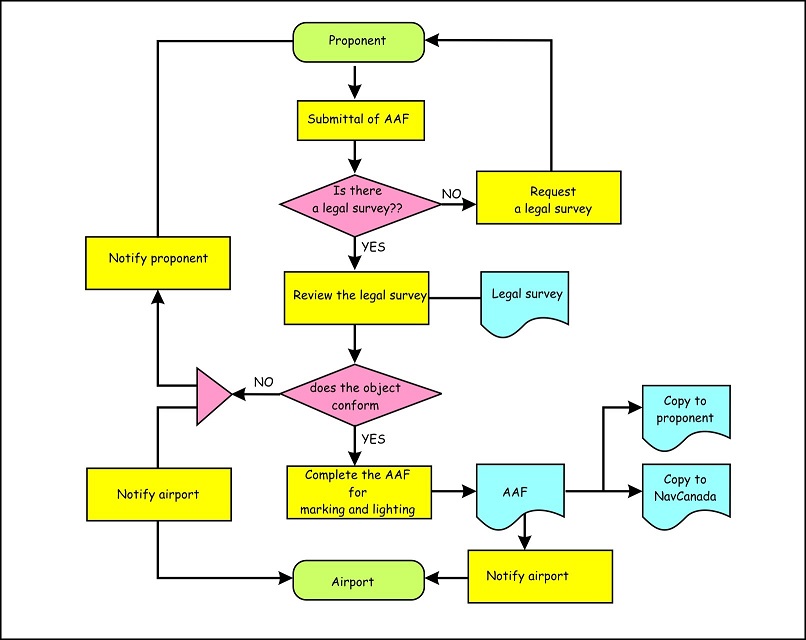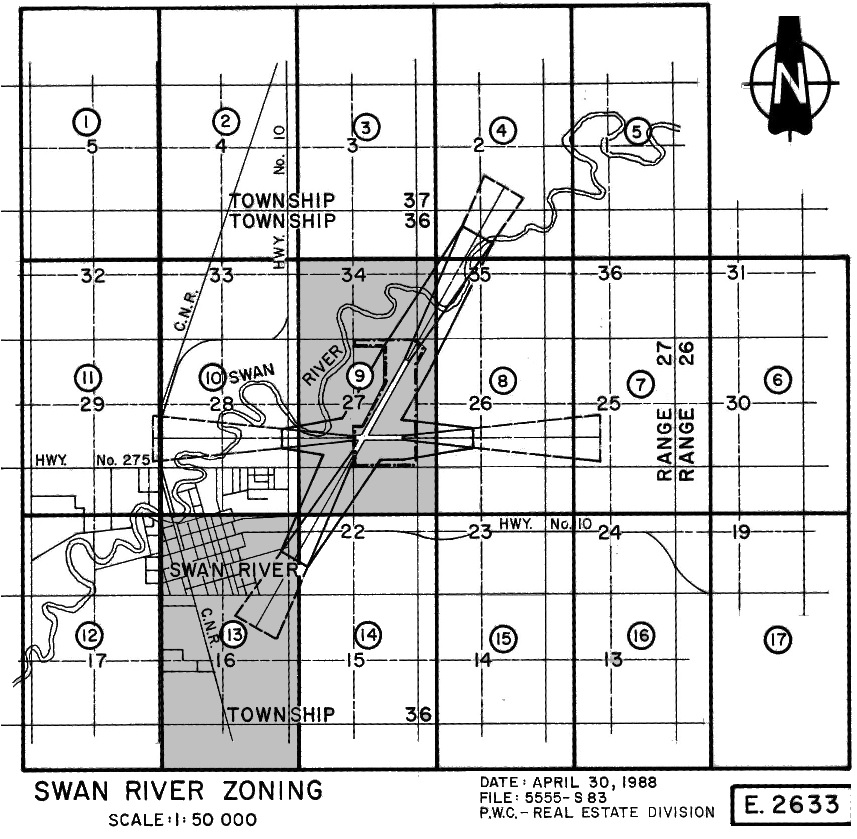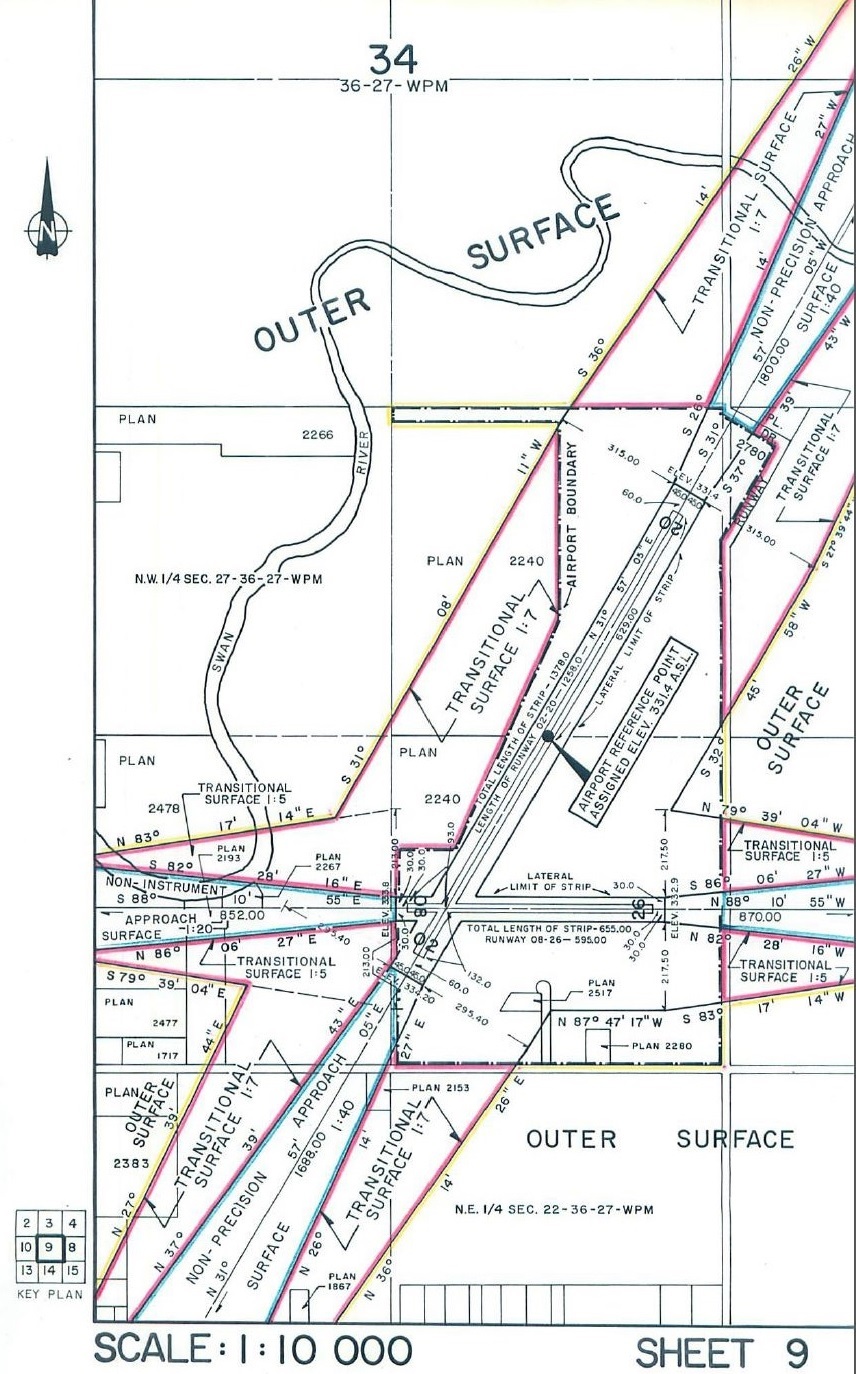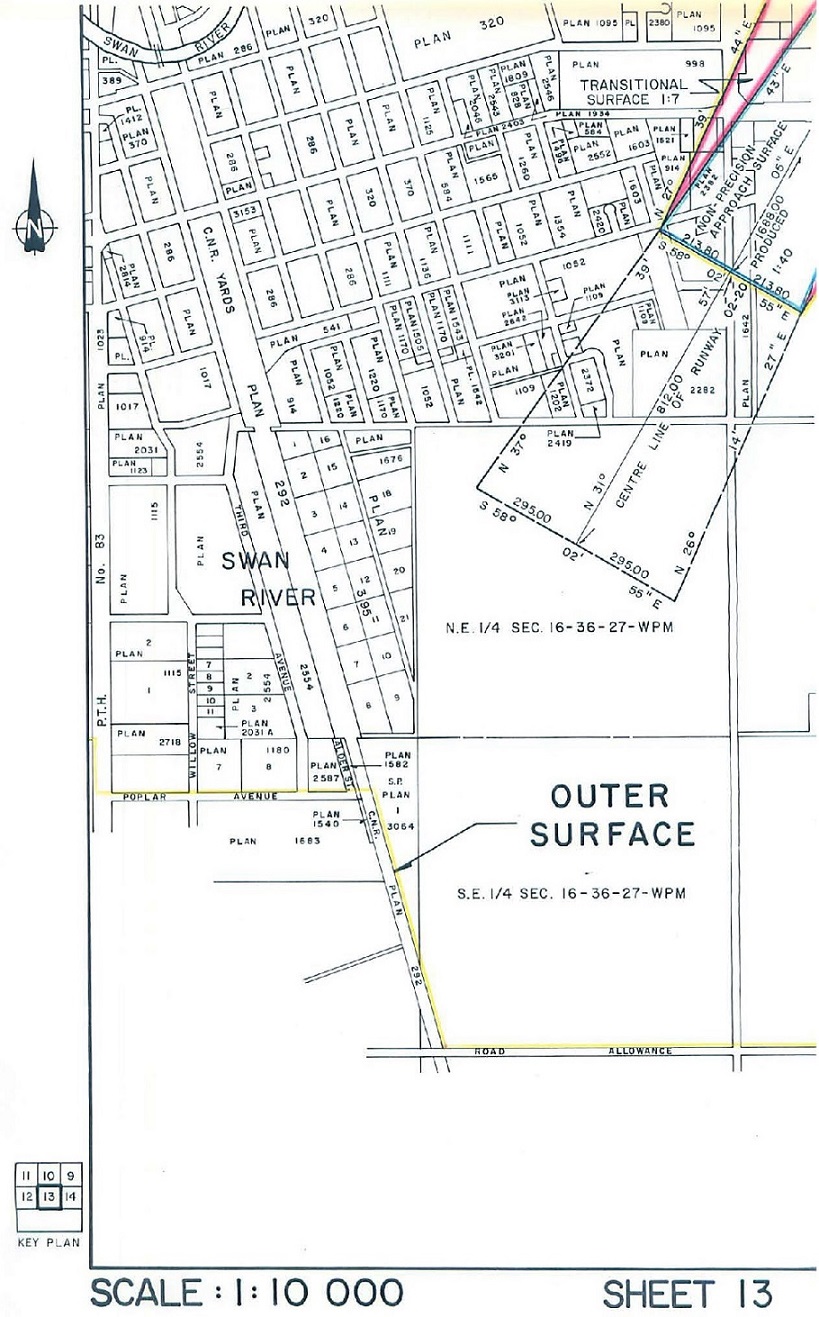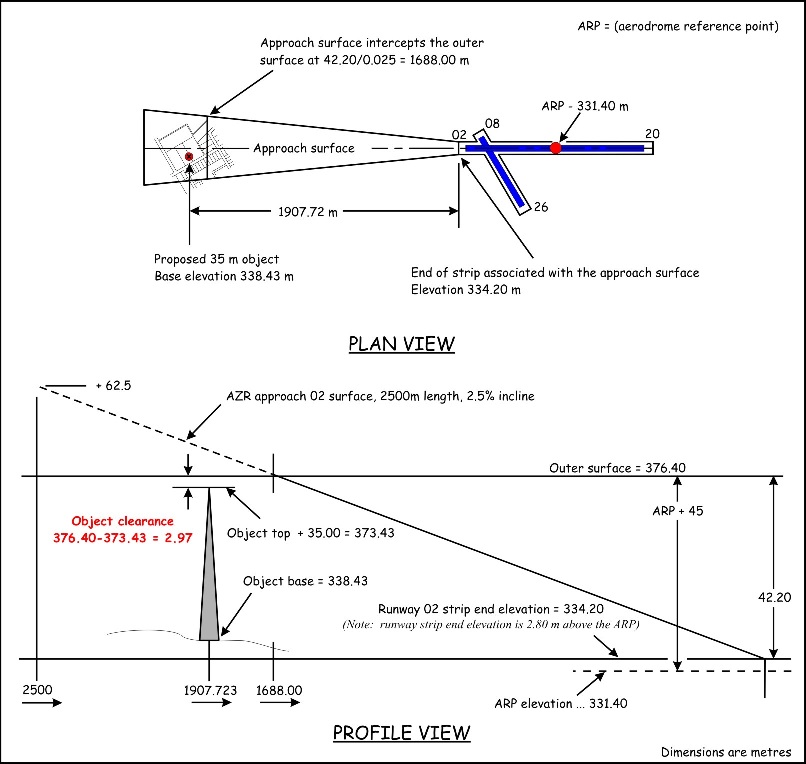Legal Land Survey for AZR Clearance Attestation
| Issuing Office: | Civil Aviation, Standards | Document No. : | AC 602-003 |
|---|---|---|---|
| File Classification No. : | Z 5000-34 | Issue No. : | 01 |
| RDIMS No. : | 10487249-V7 | Effective Date: | 2015-06-30 |
Table of Contents
- 1.0 INTRODUCTION
- 2.0 REFERENCES AND REQUIREMENTS
- 3.0 BACKGROUND
- 4.0 DISCUSSION
- 5.0 SUMMARY
- 6.0 INFORMATION MANAGEMENT
- 7.0 DOCUMENT HISTORY
- 8.0 CONTACT OFFICE
- APPENDIX A
- APPENDIX B
1.0 INTRODUCTION
- This Advisory Circular (AC) is provided for information and guidance purposes. It describes an example of an acceptable means, but not the only means, of demonstrating compliance with regulations and standards. This AC on its own does not change, create, amend or permit deviations from regulatory requirements, nor does it establish minimum standards.
1.1 Purpose
- This AC describes the process that is to be followed by the TCCA inspector for obstacle assessment through the AFF . The assessment now includes a verification of conformance of conformance of obstacles when located on lands affected by Airport Zoning Regulations (AZRs). As such, the associated purpose of this AC is to describe the legal survey that is to be provided by the proponent as evidence of conformance.
1.2 Applicability
- This AC is applicable to Transport Canada Civil Aviation (TCCA) inspectors and proponents of objects which are to be assessed through the Aeronautical Assessment form (AAF).
1.3 Description of Changes
- Not applicable.
2.0 REFERENCES AND REQUIREMENTS
2.1 Reference Documents
- It is intended that the following reference materials be used in conjunction with this document:
- Swan River Airport Zoning Regulations – SOR/90-739;
- AAF for Obstruction Marking and Lighting;
2.2 Cancelled Documents
- Not applicable.
- By default, it is understood that the publication of a new issue of a document automatically renders any earlier issues of the same document null and void.
2.3 Definitions and Abbreviations
- The following abbreviations are used in this document:
- AAF: Aeronautical Assessment Form
- ARP: Airport Reference Point
- AZR: Airport Zoning Regulation
- TCCA: Transport Canada Civil Aviation
3.0 BACKGROUND
- It is TCCA 's responsibility to enforce the AZR s which are intended to protect airports from surrounding development that is incompatible with continued accessibility, usability, and viability. It was decided in 2014 that verification of conformance to AZR s should be incorporated into the regional assessment that takes place through the AAF [forms catalog #260427] for obstacle marking and lighting.
- It became apparent, however, that there was a lack of knowledge as to what is the process and also specifically what is needed from the proponent as evidence to support their attestation when marking the appropriate check-box of Section 16 of the AAF . Further, there is a lack of guidance to inform the surveyor community as to form of evidence [i.e. the legal survey] that will fulfill the needs of the proponent and consequently of the TCCA inspector.
- Thus, the development of this AC to inform: TCCA inspectors on how the legal survey is to brought into the process of assessment; proponents of obstacles of the requirement for a legal survey as supporting evidence of conformance; and, surveyors on the of the type of information that is required in a legal survey.
4.0 DISCUSSION
Note: For purpose of discussion, this AC uses the example of AZR s for Swan River Airport as shown in Appendix B.
4.1 Aeronautical Assessment Process
- An aeronautical assessment is conducted by the
TCCA
inspector to determine the application of marking and lighting for objects that may be considered as hazards to air navigation. A determination of height conformance is also made for those objects located on lands affected by
AZR
s. The latter determination is actually a validation since the inspector does not independently ascertain conformance but rather takes note of the attestation provided by the proponent supported by a legal land survey. The process is outlined by the steps below.
Note: This process relates to assessment of proposed structures, with the premise that the height of what is eventually installed will be the same as initially proposed in the AAF . - The proponent submits a completed AAF . The appropriate check circle of Section 16 is marked and a legal land survey may be submitted.
- The inspector refers to the
AZR
for the applicable airport and decides the need for a legal land survey.
Note: If the object is located on land affected by AZR s, the proponent should have provided a legal land survey with the completed AAF . However this may not have been done and in this step the inspector identifies the need for such survey. It is not intended that the inspector would ascertain the exact location of the object to the AZR , but can reply to the proponent that the object "appears to be in close proximity" to the AZR for which a survey is needed. If there is not a submission of survey, go to Step 5. - Where the object is to be located on land subject to AZR s, the proponent marks the check-circle "YES" in Section 16 of the AAF and includes a legal land survey consisting of (1) a plan view indicating the location of the object; and (2) a profile view showing the object height, with respect to the applicable AZR surface. A typical survey is shown in Figure 2 of the Appendix A.
- The inspector determines conformance of the proposed structure on the basis of the evidence provided in the legal land survey.
Note: The inspector is making a determination on the basis of submitted legal land survey, thus the survey must indicate conformance in an obvious and clear manner. - If a legal survey has not been submitted, the inspector cannot verify conformance and the assessment for obstruction marking and lighting does not proceed.
- If the assessment is stopped, the proponent is advised to provide a legal land survey that attests the object’s location and height for the AZR .
- Upon receipt of the legal land survey the assessment is continued for applicable marking and lighting.
- If the evidence of the survey indicates that there is a penetration of an AZR surface, the assessment is stopped and the proponent is advised.
- The applicable airport is informed of the inspector's conclusion irrespective of whether or not there is a penetration.
4.2 The Zoning Regulation
- The text of airport zoning regulations can be obtained from the Government of Canada Justice Laws Website.
Aeronautics Act (R.S.C., 1985, c. A-2) - The AZR text normally specifies the ARP in Part I with the height of the ARP given in Section 2(2) Interpretation. The Approach Surfaces are specified in Part II. The Outer Surface is specified in Part III.
4.3 The Legal Survey
- Figure 6 of Appendix A illustrates a legal survey for Swan River. It is of particular importance that the surveyor prepares the plan and profile views in an unambiguous and clearly understandable manner for the reader.
Note: The units ... either feet or metres ... should follow that used in the regulation. - In this example, the plan view shows the location of the object as 1907.72 m from the end of the runway strip. The approach surface cuts through the outer surface at 1688.00 m.
- The profile view shows the object base elevation, top elevation in relation to the applicable surface which in this case is the outer surface. The surveyor must ensure that the reported top height of the object is that of the final installation. For example, some broadcast towers are placed on a pedestal such that the overall height is the height of the structure plus the pedestal.
- In this example, the outer surface is at 376.40 m and the top of the object is at 373.43 m and therefore conforms with a clearance of 2.97 m. Note that a higher object may conform to the approach surface but not to the outer surface.
4.4 Report to the Airport
- Although it may be expected that submitted objects will conform to the AZR , the applicable airport is to be informed regardless of whether or not there is conformance.
5.0 SUMMARY
- TCCA ’s responsibility is to enforce the AZR s which are intended to protect airports from surrounding development that is incompatible with continued accessibility, usability, and viability. It is the owner of the lands who is subject to the AZR s.
- The airport operator's responsibility is to comply with the Canadian Aviation Regulations (CARs) and with airport certification requirements and to notify the Minister of possible obstacles.
- It is in the best interests of the airport owner to monitor the AZR surfaces and where possible contraventions are observed or likely, to notify the Minister at the earliest opportunity.
- The role of the TCCA inspector is to determine conformance to the AZR s on the basis of the legal land survey provided by the proponent.
6.0 INFORMATION MANAGEMENT
- Not applicable.
7.0 DOCUMENT HISTORY
- Not applicable.
8.0 CONTACT OFFICE
For more information, please contact the appropriate Regional
TCCA
Office – Aerodromes and Air Navigation.
Website: Regions
Suggestions for amendment to this document are invited, and should be submitted via:
TC.FlightStandards-Normesvol.TC@tc.gc.ca
[original signed by]
Jacqueline Booth
Acting Director, Standards
Civil Aviation
APPENDIX A
Figure 1 – Flow Chart
Figure 1 is a flowchart which shows, in the form of box symbols, the actions, decisions and results described for the steps in article 4.1 Aeronautical Assessment Process. The flow is indicated by arrows between boxes and is primarily from top to bottom. That is, from the proponent to the airport. Feedbacks are indicated where notification is to be returned to the proponent.
Top box: Indicates the proponent.
2nd box: Submittal of the
AAF
.
3rd box: Decision. Is there a legal survey?
If "no"; Request a legal survey. Return to top box for notification to the proponent.
If "yes"; Proceed to review of the legal survey.
4th box: Decision. Does the object conform [to the
AZR
]?
If "no"; Notify the proponent and Notify the airport.
If "yes"; Proceed to the 5th box.
5th box: Complete the
AAF
for marking and lighting.
Send copy to proponent.
Send copy to NavCanada.
Notify the airport.
Figure 2 – Section 16 of the AAF
Figure 2 replicates Section 16 of the AAF . This section asks "Does the proposal comply with Airport Zoning Regulations. Check off boxes are provided for answers of "Yes", "No" and Not applicable".
There is a note below the check off boxes which emphasizes "Where the location of the object is on lands affected by Airport Zoning Regulations, a legal survey is required with the submittal".
Figure 3 – AZR Plan
Figure 3 is the index page from the Swan River Zoning plan. The page is a 1:50,000 scale map of the area around the airport showing a grid applicable to the 17 sheets of the zoning plan. In Figure 3 shading is used to highlight sheets 9 and 13 which are of importance for the particular case of a 35 m object to be installed under the approach surface for runway 02.
Figure 4 – Sheet 9 of the AZR plan showing the ARP and Runway End Strip elevation
Figure 4 replicates sheet 9 of the Swan River zoning plan. This sheet at a scale of 1:10,000 provides elevations for the ARP and that of the strip end for runway 02. These elevations are required for calculation of clearances.
Figure 5 – Sheet 13 0f AZR plan showing surfaces away from the airport
Figure 5 replicates sheet 13 of the Swan River zoning plan. This sheet at a scale of 1:10,000 shows the area in which the proposed object is to be installed. The edges of the approach surface and of the outer surface are indicated in colours of green and yellow respectively.
Figure 6 – Legal Land Survey
Figure 6 is an illustration of what should be provided in the legal survey. In this case, the object is a 35 m high tower located under the approach surface of runway end 02 at Swan River Airport. The figure has two schematics; a plan view and a profile view.
The intent of the figure is to show that although the object is under the approach surface, the outer surface is the determining factor for conformance to AZR s.
The top schematic of Figure 2 is a plan view of the runway, the approach surface and the distance of the object from the end of the runway strip. The elevation of the strip end is 334.2 m and the base of the tower is at 338.43 m.
The second schematic of Figure 2 is a profile view showing the approach surface, the outer surface and the object. The schematic gives notation that the end of the runway strip is 2.8 m above the ARP which defines the height of the outer surface (i.e. 45 m above the ARP equals 376.4 m). The ARP is given in the AZR as 331.4 m. The top of the tower is at 373.43 m above the runway strip end. Thus the clearance from the outer surface is 376.4 m minus 373.43 m equals 2.97 m and the legal survey therefore shows conformance to the AZR s.
APPENDIX B
Swan River Airport Zoning Regulations
SOR/90-739
SHORT TITLE
1. These Regulations may be cited as the Swan River Airport Zoning Regulations.
INTERPRETATION
2. (1) In these Regulations,
“airport” means the Swan River Airport, in the vicinity of Swan River in the Province of Manitoba; (aéroport)
“airport reference point” means the point described in Part I of the schedule; (point de repère de l’aéroport)
“approach surface” means an imaginary inclined plane that extends upward and outward from each end of a strip, which approach surface is more particularly described in Part II of the schedule; (surface d’approche)
“Minister” means the Minister of Transport; (ministre)
“outer surface” means an imaginary surface located above and in the immediate vicinity of the airport, which outer surface is more particularly described in Part III of the schedule; (surface extérieure)
“strip” means the rectangular portion of the landing area of the airport, including the runway, prepared for the take-off and landing of aircraft in a particular direction, which strip is more particularly described in Part IV of the schedule; (bande)
“transitional surface” means an imaginary inclined plane that extends upward and outward from the lateral limits of a strip and its approach surfaces, which transitional surface is more particularly described in Part V of the schedule. (surface de transition)
(2) For the purposes of these Regulations, the elevation of the airport reference point is 331.4 m above sea level.
APPLICATION
3. These Regulations apply to all the lands, including public road allowances, adjacent to or in the vicinity of the airport, which lands are more particularly described in Part VI of the schedule.
GENERAL
4. No person shall erect or construct on any land to which these Regulations apply, any building, structure or object or any addition to any existing building, structure or object, the highest point of which will exceed in elevation at the location of that point
(a) the approach surfaces;
(b) the outer surface; or
(c) the transitional surfaces.
NATURAL GROWTH
5. Where an object of natural growth on any land to which these Regulations apply exceeds in elevation any of the surfaces referred to in paragraphs 4(a) to (c), the Minister may require that the owner or occupier of the land on which that object is growing remove the excessive growth.
DISPOSAL OF WASTE
6. No owner or occupier of any land to which these Regulations apply shall permit such land or any part of it to be used for the disposal of any waste that is edible by or attractive to birds.
SCHEDULE (Sections 2 and 3)
PART I
DESCRIPTION OF THE AIRPORT REFERENCE POINT
The airport reference point shown on Swan River Airport Zoning Plan No. E.2633 dated April 30, 1988, is a point located on the centre line of runway 02-20 distant 629.0 m from the northeasterly end of the said runway.
PART II
DESCRIPTION OF THE APPROACH SURFACES
The approach surfaces, shown on Swan River Airport Zoning Plan No. E.2633 dated April 30, 1988, are surfaces abutting each end of the strips associated with runways designated 02-20 and 08-26, and are described as follows:
(a) a surface abutting the end of the strip associated with runway approach 02 consisting of an inclined plane having a ratio of 1 m measured vertically to 40 m measured horizontally rising to an imaginary horizontal line drawn at right angles to the projected centre line of the strip and distant 2 500 m measured horizontally from the end of the strip; the outer ends of the imaginary horizontal line being 295 m from the projected centre line; said imaginary horizontal line being 62.5 m measured vertically above the elevation at the end of the strip;
(b) a surface abutting the end of the strip associated with runway approach 20 consisting of an inclined plane having a ratio of 1 m measured vertically to 40 m measured horizontally rising to an imaginary horizontal line drawn at right angles to the projected centre line of the strip and distant 2 500 m measured horizontally from the end of the strip; the outer ends of the imaginary horizontal line being 295 m from the projected centre line; said imaginary horizontal line being 62.5 m measured vertically above the elevation at the end of the strip;
(c) a surface abutting the end of the strip associated with runway approach 08 consisting of an inclined plane having a ratio of 1 m measured vertically to 20 m measured horizontally rising to an imaginary horizontal line drawn at right angles to the projected centre line of the strip and distant 2 500 m measured horizontally from the end of the strip; the outer ends of the imaginary horizontal line being 280 m from the projected centre line; said imaginary horizontal line being 125 m measured vertically above the elevation at the end of the strip; and
(d) a surface abutting the end of the strip associated with runway approach 26 consisting of an inclined plane having a ratio of 1 m measured vertically to 20 m measured horizontally rising to an imaginary horizontal line drawn at right angles to the projected centre line of the strip and distant 2 500 m measured horizontally from the end of the strip; the outer ends of the imaginary horizontal line being 280 m from the projected centre line; said imaginary horizontal line being 125 m measured vertically above the elevation at the end of the strip.
PART III
DESCRIPTION OF THE OUTER SURFACE
The outer surface, shown on Swan River Airport Zoning Plan No. E.2633 dated April 30, 1988, is an imaginary surface located at a common plane established at a constant elevation of 45 m above the elevation of the airport reference point, except that, where that common plane is less than 9 m above the surface of the ground, the outer surface is an imaginary surface located at 9 m above the surface of the ground.
PART IV
DESCRIPTION OF THE STRIPS
The strips, shown on Swan River Airport Zoning Plan No. E.2633 dated April 30, 1988, are described as follows:
(a) the strip associated with runway 02-20 is 90 m in width, 45 m being on each side of the centre line of the runway, and 1 378 m in length; and
(b) the strip associated with runway 08-26 is 60 m in width, 30 m being on each side of the centre line of the runway, and 655 m in length.
PART V
DESCRIPTION OF THE TRANSITIONAL SURFACES
The transitional surfaces, shown on Swan River Airport Zoning Plan No. E.2633 dated April 30, 1988, are described as follows
(a) the transitional surface associated with runway 08-26 is a surface consisting of an inclined plane rising at a ratio of 1 m measured vertically to 5 m measured horizontally at right angles to the centre line and projected centre line of the strip extending upward and outward from the lateral limits of the strip and its approach surfaces to an intersection with the outer surface or another transitional surface of an adjoining strip; and
(b) the transitional surface associated with runway 02-20 is a surface consisting of an inclined plane rising at a ratio of 1 m measured vertically to 7 m measured horizontally at right angles to the centre line and projected centre line of the strip extending upward and outward from the lateral limits of the strip and its approach surfaces to an intersection with the outer surface or another transitional surface of an adjoining strip.
PART VI
DESCRIPTION OF THE LANDS TO WHICH THESE REGULATIONS APPLY
The boundary of the outer limits of lands, shown on Swan River Airport Zoning Plan No. E.2633 dated April 30, 1988, is described as follows:
- Commencing at the southwest corner of the southeast quarter of Section 5, Township 37, Range 27, West of the Principal Meridian;
- Thence northerly along the westerly limit of the southeast quarter of Section 5 to the northwest corner of the said southeast quarter of Section 5;
- Thence easterly along the northerly limit of the southeast quarter of Section 5 and across the intervening road allowance to the southwest corner of the northwest quarter of Section 4;
- Thence northerly along the westerly limit of the northwest quarter of Section 4 to the northwest corner of Section 4;
- Thence easterly along the northerly limits of Sections 4, 3 and 2 and across the intervening road allowances to the northeast corner of Section 2;
- Thence southerly along the easterly limit of the northeast quarter of Section 2 to the southeast corner of the northeast quarter of Section 2;
- Thence easterly across the intervening road allowance and along the northerly limit of the south half of Section 1 to the northeast corner of the southeast quarter of Section 1;
- Thence southerly along the easterly limits of the southeast quarter of Section 1, the northeast quarter of Section 36, Township 36, Range 27, West of the Principal Meridian, and across the intervening road allowance to the southeast corner of the said northeast quarter of Section 36;
- Thence easterly across the intervening road allowance and along the northerly limit of the southwest quarter of Section 31, Township 36, Range 26, West of the Principal Meridian to the northeast corner of said southwest quarter of Section 31;
- Thence southerly along the easterly limits of the southwest quarter of Section 31, the westerly half of Section 30, the northwest quarter of Section 19 and across the intervening road allowance to the southeast corner of the northwest quarter of Section 19;
- Thence westerly along the southerly limit of the northwest quarter of Section 19 and across the intervening road allowance to the northeast corner of the southeast quarter of Section 24, Township 36, Range 27, West of the Principal Meridian;
- Thence southerly along the easterly limits of the southeast quarter of Section 24 and the northeast quarter of Section 13 to the southeast corner of the northeast quarter of the said Section 13;
- Thence westerly along the southerly limit of the northeast quarter of Section 13 to the southwest corner of the said northeast quarter of Section 13;
- Thence southerly along the easterly limit of the southwest quarter of Section 13 to the southeast corner of the said southwest quarter of Section 13;
- Thence westerly along the southerly limits of the southwest quarter of Section 13, Section 14, Section 15 and the southeast quarter of Section 16 and the intervening road allowances to an intersection with the northeasterly limit of Registered Plan No. 292, Dauphin Land Titles;
- Thence northwesterly along the northeasterly limit of said Plan No. 292 to an intersection with the easterly production of the northerly limit of Poplar Avenue as shown on Plan No. 2587 Dauphin Land Titles;
- Thence westerly along the northerly limit of Poplar Avenue and intervening road allowances and Plans 292, 1582 and 1023, Dauphin Land Titles, to an intersection with the westerly limit of said Plan 1023;
- Thence northerly along the westerly limit of said Plan 1023 to an intersection with the southerly limit of the northeast quarter of Section 17;
- Thence westerly along the southerly limit of the northeast quarter of Section 17 to the southwest corner of the said northeast quarter of Section 17;
- Thence northerly along the westerly limit of the northeast quarter of Section 17 and the southeast quarter of Section 20 to an intersection with the northeasterly bank of the Swan River;
- Thence northwesterly along the northeasterly bank of the Swan River to the easterly limit of Parcel 1, Plan 1344, Dauphin Land Titles;
- Thence northerly along the easterly limit of Parcel 1, Plan 1344 and its production across Plan 2776, Dauphin Land Titles, to an intersection with the northerly limit of said Plan 2776;
- Thence westerly along the northerly limit of Plan 2776 to the southeast corner of Parcel 1, Plan 1552, Dauphin Land Titles;
- Thence northerly along the easterly limits of Parcel 1, Plan 1552, Lots 2 and 3, Block 1, Plan 2547, Dauphin Land Titles, to the northeast corner of Lot 2, Plan 2547;
- Thence westerly along the northerly limit of Lot 2, Plan 2547 and across Willowrun Drive to the northeast corner of Block 2, Plan 2547;
- Thence northerly across Westwind Road and along the easterly limit of Block 3, Plan 2547 to the northeast corner of the said Block 3, Plan 2547;
- Thence westerly along the northerly limit of Block 3, Plan 2547, to the northwest corner of said Block 3, Plan 2547;
- Thence northerly along the westerly limits of the northwest quarter of Section 20, Section 29, southwest quarter of Section 32 and across the intervening road allowance to the northwest corner of the southwest quarter of Section 32;
- Thence easterly along the northerly limit of the southwest quarter of Section 32 to the northeast corner of the southwest quarter of Section 32;
- Thence northerly along the westerly limit of the northeast quarter of Section 32 and across the intervening road allowance to the southwest corner of the southeast quarter of Section 5, Township 37, Range 27, West of the Principal Meridian being the point of commencement.
AC 602-003 - Legal Land Survey for AZR Clearance Attestation
(
PDF
, 1.47
MB
)
